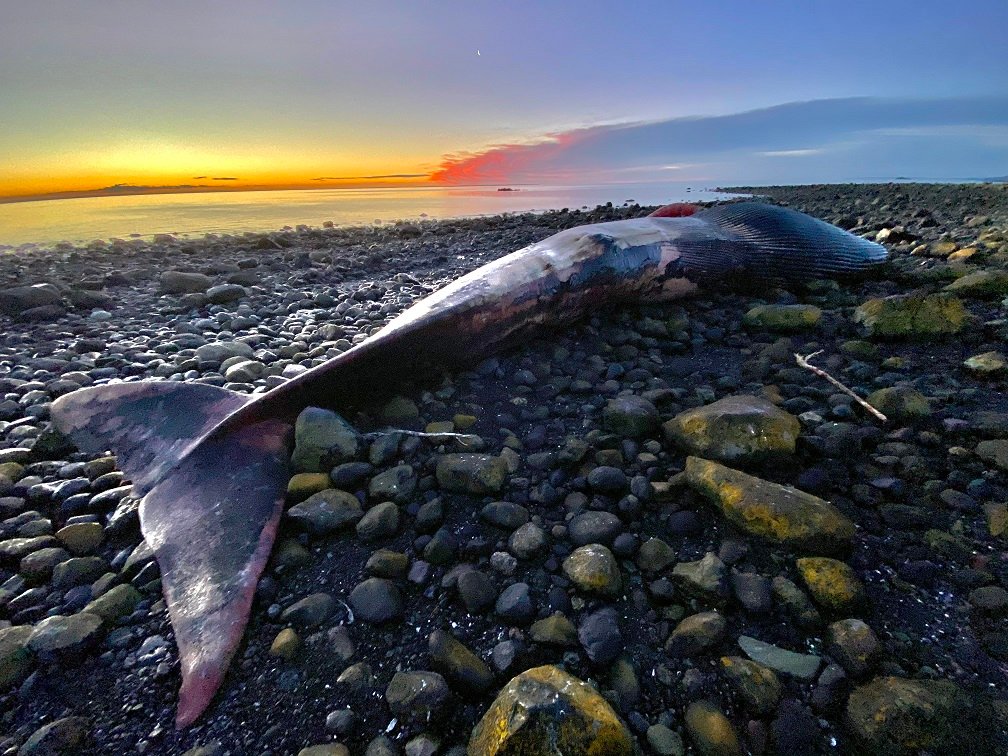Los Lagos: The National Fisheries and Aquaculture Service (Sernapesca) confirmed that the cause of death of the blue whale stranded the week before last in Chumeldén, Lagos Region, was due to a ship strike. The information was released after the preliminary results of the necropsy performed last Friday.
This was reported by veterinarian Mauricio Ulloa, a specialist in cetaceans from Sernapesca’s Conservation and Biodiversity Unit, who supervised the procedure carried out by specialists from the NGO Panthalassa and MERI Foundation, organizations with special programs dedicated to the care and conservation of cetaceans.
Ulloa detailed that it was a juvenile male specimen of just over 14 meters in length and weighing 30 tons. “The carcass was in stage 4 of preservation, which means that it presented a certain degree of decomposition, scavenger attacks and skin detachment.”
At the thoracic level there was a large hematoma suggesting a major collision. Subsequently, when the muscular layer was removed, we saw the heart was outside the thoracic cavity, which indicates that the impact was so severe that it caused the death of the animal.”
Similarly, the scientific director of the NGO Panthalassa, Frederick Toro, explained that the necropsy was carried out simultaneously on three sections of the animal. This allowed them to determine that “externally it had some minor skin lesions probably associated with fishing gear, but when we entered the thoracic cavity we found a hematoma and bloody fluid in the ventral area. The heart showed a lesion at the apex and the cardiac muscle with hemorrhage, all of which is indicative of being struck by a ship of considerable size.”
STRENGTHENING THE PROTECTION OF LARGE CETACEANS
This incident highlights the importance of working on measures to mitigate and prevent interactions between cetaceans and vessels, which would require the coordination between public and private entities. This was stated by Ana María Molina, executive director of MERI, who pointed out that, “this leads us to stress how urgent it is to take the necessary measures to prevent these events from happening. For this reason, since last year we have been working together with the Ministry of the Environment and many other institutions to develop The Blue BOAT Initiative in the area of the Gulf of Corcovado and to the south. This project seeks to develop an early warning system so vessels can avoid these collisions. This project together with the actions of each sector, including the communities, will be a great contribution to the protection of these cetaceans that provide so many ecosystem services to nature.”
Ricardo Sáez, head of Sernapesca’s Conservation and Biodiversity Unit, highlighted this type of initiative, noting that as an institution, “it is essential to have the support of civil society through projects such as Blue Boat, which will provide acoustic buoys to detect the presence of large cetaceans and warn vessels in the area.” For Sáez, this project aligns with the efforts made by the State through Sernapesca and the rest of the fishing, environmental and maritime institutions, each one based on the scope of their obligations, in initiatives such as the Underwater Noise Committee, the Conservation and Management Plan for the Southern Right Whale, the evaluation of the interaction of the Chilean dolphin with coastal fishing and aquaculture activities, the surveillance in Marine Parks and Reserves, among others.
In addition, Sernapesca created in 2017 the National Marine Wildlife Stranding Response Network, and more recently the National Large Cetacean Disentanglement Network, that was just presented to the Scientific Committee of the International Whaling Commission. Furthermore, during the pandemic, the Service has conducted a series of open talks and workshops where aspects such as ecology, behavior and response to stranding of large cetaceans are addressed.
Finally, the head of the unit pointed out that there are already two resolutions of the Maritime Authority, one mandatory and the other voluntary, which regulate the transit and speed of vessels in two areas of the country known for the constant presence of whales: Mejillones Bay and the Gulf of Corcovado. In this sense, he indicated that the objective is to expand and strengthen this joint work of institutions, academia, and citizens, to achieve safe seas for the movement of these valuable animals.
Source: Sernapesca





